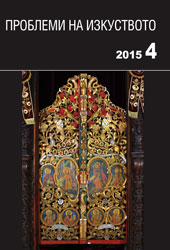За някои особености в тематичните предпочитания на дебърските и самоковските зографи
On Certain Particularities of the Thematic Choices of Icon-Painters from Debar And Samokov
Author(s): Elena GenovaSubject(s): History, Fine Arts / Performing Arts, Visual Arts, Modern Age, 19th Century
Published by: Институт за изследване на изкуствата, Българска академия на науките
Summary/Abstract: This paper contains observations of the authors and concise notes on certain particularities of the thematic choices of two of the most significant art schools in the Southern Balkans, that of Debar and Samokov. The roads taken by Zographs or teams of icon-painters, the shared models they have used and often the different directions from which they have arrived to them, the contacts between the painters–often indirect–that have worked at the same place, but in different periods, set the dynamism of the phenomena and their expression. The on-going processes in both schools were synchronous and the leading icon-painters worked. The notes on their thematic choices are based mainly on the leading painters from Debar, Dičo/Dimiter Krstev and his son Avram Dičov. The conceptual, iconographic and stylistic changes, determinative of the nature of church painting at the turn of the post-Byzantine period and the modern times are evidenced best at the same area, within the same architectural and symbolic space of an Orthodox church: the narthex and the porch. These are where all the quintessence of social relations, the morality and the faith of a Renaissance man are concentrated. Moral, didactic and eschatological subjects were intended to prepare the worshipers to gear themselves up for rethinking their lives and sins and correspondingly, for their expectations for the end of the age (The Last Judgment; The Ordeals; A Righteous and Sinful Confession; Going to a Witchdoctor for a Cure; The Wheel of Life; Michael the Archangel Takes the Soul of the Rich man, etc.). The conceptual and thematic innovations in the decorative and iconographic programme of the altar space (ecce Homo; Christ Great Hierarch from The Communion of the Apostles; Allegory of the Eucharist) and such rare subjects as The Trial of Jesus Christ Before Pilate; The Holy New Testament Trinity/Synthronon and The Coronation of the Most Holy Mother of God became emblematic of the nineteenth-century Orthodox painting. The same is true of the image of the Winged Virgin Mary. And, last but not least, the new moments in the development of the cult of the enlighteners of the Slavs.
Journal: Проблеми на изкуството
- Issue Year: 2015
- Issue No: 4
- Page Range: 9-18
- Page Count: 10
- Language: Bulgarian
- Content File-PDF

